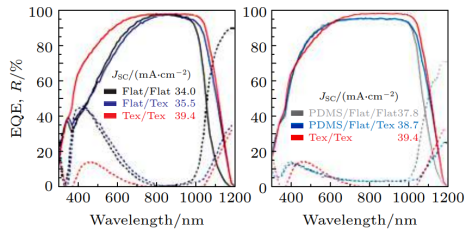
量子效率测试仪
PL/EL一体机
Sinton硅片少子寿命测试仪
Sinton硅块少子寿命测试仪
绒面反射率测试仪
3D共聚焦显微镜
清洗制绒工作站
在线四探针方阻测试仪
全自动扫描四探针方阻测试仪
在线薄膜厚度测试仪
晶化率测试仪
Horiba显微共焦拉曼光谱仪
傅里叶红外光谱仪
霍尔效应测试仪
分光光度计
全光谱椭偏仪
Horiba椭圆偏振光谱仪
TLM接触电阻率测试仪
超景深显微镜
网版智能影像测量仪
全自动影像测量仪
卧式拉力机
电池片稳态光衰老化试验箱
电池片紫外老化试验箱
电池片拉脱力综合测试仪
外观检验台
湿漏电测试系统
组件实验室EL测试仪
紫外老化试验箱
稳态光衰老化试验箱
电流连续性监测系统
PID测试系统
旁路二极管测试系统
LeTID测试系统
反向电流过载系统
脉冲电压测试系统
绝缘耐压测试仪
接地连续性测试仪
绝缘耐压接地测试仪
湿热环境试验箱
湿冻环境试验箱
热循环试验箱
动态机械载荷测试机
静态机械载荷测试机
冰雹冲击试验机
引出端强度试验机
霰弹冲击试验机
抗划伤(切割)测试机
剥离试验机
万能材料试验机(单臂)
万能材料试验机(双臂)
光伏玻璃透过率测试仪
醋酸测试试验箱
交联度测试系统
二极管接线盒综合测试仪
落球冲击试验机
半自动四探针
全自动探针式台阶仪
多通道太阳能MPPT系统
Horiba稳瞬态荧光光谱仪
钙钛矿P1激光划线测试仪
钙钛矿在线膜厚测试仪
钙钛矿工艺检测工作站
手持式IV测试仪
便携式EL测试仪
手持热成像测试仪
户外组件IV测试仪
户外组件多通道测试系统
光伏逆变器电能质量测试仪
无人机EL检测仪
减少钙钛矿/硅叠层太阳能电池中的反射损耗研究
日期:2024-03-25浏览量:10
钙钛矿太阳能电池是以钙钛矿型晶体为主要吸光材料的太阳能电池,具有高光电转换效率、结构简单、制备工艺多样化、成本低等优点。目前,单结钙钛矿太阳能电池的理论转换效率可达33%,而现在受到市场广泛关注的钙钛矿/硅串联太阳能的理论转化效率可达43%,且具有突破单结太阳能电池Shockley-Queisser极限的潜力。然而,内部界面的反射损耗对串联电池的整体效率起着至关重要的作用。来自美能的RTIS绒面反射仪,可以测试制绒片对不同波长段的光反射率强度,并进行多点自动测量,最终以可视化曲线呈现测试结果,帮助客户监控电池片反射率、膜厚信息。

反射损失的研究
太阳能电池光学损失主要包括反射损失和寄生吸收等两方面。减少电池中的反射损失途径主要包括两方面,一是在太阳能电池前表面设计一层减反射层,增加前表面抗反射能力。二是使用绒度衬底,将进入太阳能电池的光吸收最大化。两者都能有效的提高光吸收。
寄生吸收
首先,我们简单介绍下寄生吸收。太阳能电池中非活性层的吸收称为寄生吸收,这些吸收对太阳电池中的短路电流密度没有贡献,所以对寄生吸收的改善在光学优化中很重要。在非吸收层中,造成寄生吸收的主要原因是透明导电层对光的吸收。透明导电层主要有石墨烯、银纳米线电极、MoOx作为缓冲层的薄金属层、掺锌的氧化铟(indium zinc oxide,IZO)或者ITO等,每种材料都有其优缺点。
分析太阳能电池的光损耗,能直接看出所有材料的寄生吸收,从而针对性发对寄生吸收大的材料进行厚度、材料、带隙等方面的优化。不同结构的太阳能电池引起主要寄生吸收的材料不同,优化方式也随之改变。寄生吸收的优化对叠层电池光学优化有着十分重要的影响。
反射损失
在钙钛矿/硅叠层太阳能电池中,反射损耗占光学损耗的很大一部分,而减反射层的设计可以降低光反射,增加光吸收。减反层通常使用的材料有LiF和MgF2材料,或LM箔和PDMS等反射层结构。
2017年,美国亚利桑那州立大学Manzoor等人,将带有无规则金字塔的PDMS聚合物制成的涂层,使用在具有平面前后表面制绒的硅电池片上,分别获得了3.0和1.7mA/cm2的短路电流密度提升,并且将此涂层运用到钙钛矿太阳能电池上。PDMS层由于较小的折射率,能够降低太阳能电池正面反射率和调整叠层电池的电流失配问题。

有、无PDMS减反层的太阳能电池EQE对比
2018年,德国亥姆霍兹研究所在叠层电池的正面采用了制绒的LM箔,叠层器件效率从23.4%提升至25.5%。

LM箔作减反层的优化结果对比
不过由于PDMS和LM箔是一种聚合物,光学性质的模拟工作复杂,所以很多工作中减反层用的都是MgF2和LiF,并且MgF2和LiF的吸收较低,工艺上能做到厚度更薄,对于入射光的减反射效果较好。
德国亥姆霍兹研究所在2019年把LiF应用在叠层电池中,同时对钙钛矿厚度进行优化,最后获得了26%的转换效率和1.4mA/cm2的短路电流密度提升。同年,德国弗劳恩霍夫太阳能系统研究所也使用了另一种减反射材料MgF2,光学性能得到大大改善。

LiF(左)、MgF2(右)作减反层的电池优化结果对比
衬底陷光结构
在钙钛矿/硅叠层太阳能电池中,衬底陷光结构能使入射光在太阳能电池内部进行多次反射,充分吸收光从而减少反射损失。通过制绒可以使衬底表面织构化,形成类金字塔的陷光结构,这样的陷光结构对红外光子的吸收增加,产生更多的光生载流子,电池整体的电流和效率也随之提高。因此对衬底陷光结构的优化也非常重要,有效的陷光结构设计能大幅度提升电池性能。

未使用(左)、使用(右)陷光结构的电池EQE图
没有衬底陷光结构的太阳能电池,即平面硅表面上沉积钙钛矿顶电池的叠层电池的反射损失很严重。双面制绒的硅作为底电池的叠层电池光学性能最优。

具有单面制绒、双面制绒的太阳能电池的光损耗对比图
美能RTIS绒面反射仪

美能RTIS绒面反射仪是太阳能电池片生产厂商工艺检测的重要帮手。可以测试制绒片对不同波长段的光的反射率强度,通过漫反射激发电池片,用8度角采用光谱仪进行检测。RTIS具有定位的机台和导轨,能够方便而快速地送入样品,实现电池片样品的定位,提高使用人员的工作效率。
● 光谱测试范围可达350-1050nm
● 快速、自动任意多点测量
● 每点测试速度约0.1s,检测时间仅为传统反射率的1/10
● 精准测量反射率、膜厚等多项重要参数
光伏行业是一个以成本为导向的行业,降本增效是发展核心,而持续提升光伏电池的转换效率是降低整个光伏发电成本的有效举措。近年来,钙钛矿/硅叠层太阳能电池的转换效率快速提升,一旦这种高效率的电池技术真正实现量产,将促进光伏发电成本大幅下降,都能大力推动我国乃至全球光伏行业的发展。




































































